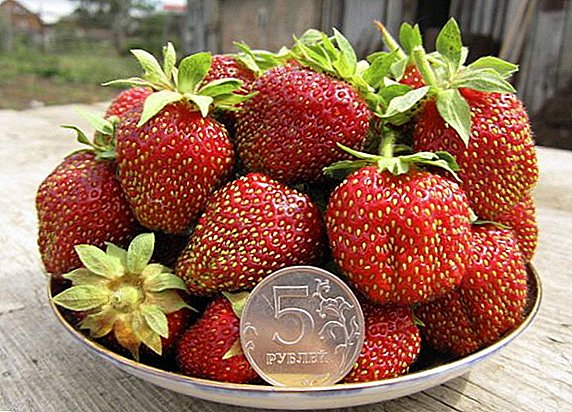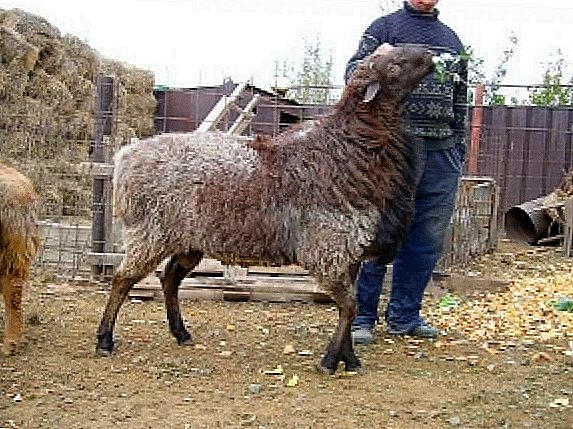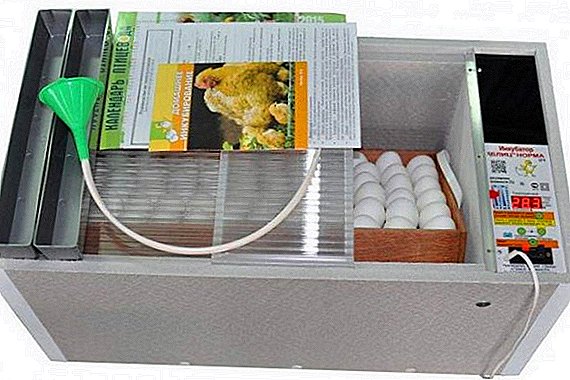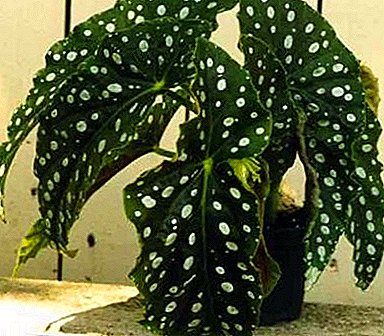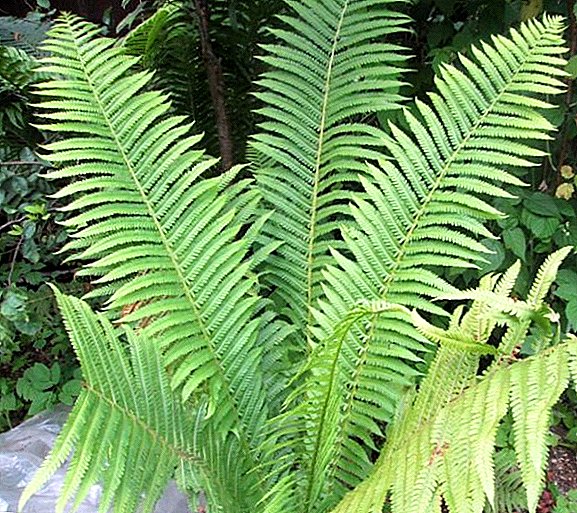 About a plant called "fern" know many. It has gained popularity due to the legend of the Kupala night, in which the fern supposedly blooms. To the one who finds such a flower, happiness will smile. We will not vouch for the authenticity of the legend, but we can say for sure that the fern is a magically beautiful plant with which it is easy to decorate any yard and garden. The main thing - to love the fern and know how to plant it. But no one has ever seen a blooming fern, at least there is no official confirmation of this phenomenon. But this circumstance does not prevent the plant to be among the leaders among the many elements of garden decor.
About a plant called "fern" know many. It has gained popularity due to the legend of the Kupala night, in which the fern supposedly blooms. To the one who finds such a flower, happiness will smile. We will not vouch for the authenticity of the legend, but we can say for sure that the fern is a magically beautiful plant with which it is easy to decorate any yard and garden. The main thing - to love the fern and know how to plant it. But no one has ever seen a blooming fern, at least there is no official confirmation of this phenomenon. But this circumstance does not prevent the plant to be among the leaders among the many elements of garden decor.
There are about 10 thousand varieties of fern, which allows each gardener to choose the variety he liked. Let's take a closer look at the features of this plant and answer the question of how to grow a fern in the garden.
Did you know? The fern is considered to be one of the most ancient plants, since it appeared on Earth several million years ago.
Garden fern: general characteristics
 Fern varieties differ from each other in size, cycles and life forms (woody and herbaceous), and structural features. However, outwardly they are very similar, many do not even suspect that this is the largest group of spore plants. Ferns differ also in various forms of leaves, resistance to excess of moisture and ecological plasticity.
Fern varieties differ from each other in size, cycles and life forms (woody and herbaceous), and structural features. However, outwardly they are very similar, many do not even suspect that this is the largest group of spore plants. Ferns differ also in various forms of leaves, resistance to excess of moisture and ecological plasticity.
What types of ferns are suitable for growing in the garden
Today, the fern is very popular with many gardeners who have studied its planting and care in the open field. They are decorated with gardens, ponds, create wonderful landscape compositions.
We will list several types of winter-hardy fern, which will feel good in the garden in our climate and are excellent for growing:
- Orlyak ordinary. Beautiful view. Its roots are used in traditional medicine. The height of this fern is 80 cm.
- The ladder is female. Reaches a meter in height. In one place lives up to 10 years.
- Shchitovnik male. Very high fern, which can drive up to 1.5 m, but grows slowly. Propagated by rhizome segments. Excellent fern garden, cultivation and care of this plant are not difficult.
- Bush bush. Evergreen large fern.
- Ostrich bird ordinary. This type of fern very quickly creates spectacular lush thickets. Feels great both in the shade and in the sun.
- Asplenium The people call him Kostenets. Many asleniums love heat, but some are cold-resistant and can survive the cold to -18 ° C. Growing this type of fern in the garden today is very popular.
- The nesting asplenium grows even without soil, since it is used in nature to take root on heaps of foliage, snags and trunks. It grows up to 1 m in length. In specialized stores you can buy dwarf varieties of this fern.
- Lukovitsenosny asplenium - deciduous fern. Its historical homeland is New Zealand. This species can be grown in the garden, if the roots are covered with a layer of dry leaves for the winter or dig up and store them in the cellar until spring along with a clod of earth. Plant length is about 60 cm.
- Vivipating asplenium. On the upper side of the bent, dissected leaves buds grow and fall to the ground, turning into new specimens.
How to choose a place on the site for garden fern
 Fans of this plant should know how to plant a fern. First of all, you need to understand that without exception, all species of this plant love shade and moisture, so the fern has its own specificity of planting and care in the future. If there are secluded dark places in your country house where other plants feel uncomfortable, you can plant a fern there. It easily transfers destructive conditions for other representatives of the flora and can grow in the soil without fertilizers.
Fans of this plant should know how to plant a fern. First of all, you need to understand that without exception, all species of this plant love shade and moisture, so the fern has its own specificity of planting and care in the future. If there are secluded dark places in your country house where other plants feel uncomfortable, you can plant a fern there. It easily transfers destructive conditions for other representatives of the flora and can grow in the soil without fertilizers.
The depth of the hole and the distance between adjacent bushes is determined from the size of the adult plant. If you plant long-rhizo species of fern, take more space for them, because they can strongly press the adjacent plants. You can also artificially limit their area.
Do I need fern lighting
The fern tolerates shade well, but a long absence of sunlight can be bad for the leaves - they turn yellow and dull over time. It does not harm the plant, but its appearance deteriorates. The best lighting for a fern is diffused sunlight. The direct rays of the sun should not fall on it.
What should be the soil for planting
 To the question: what kind of land do ferns love, is it easy to give an answer even to a novice gardener. Of course, the soil should be loose and well absorb moisture. So that the water in the ground does not stagnate and does not provoke the putrefactive processes on the roots, you will need river sand or other drainage. To the excavated ground, add peat and sand in a ratio of 2: 2: 1. Moisten the well well and gently place the plant in it. On the roots of the fern should be as much as possible of the soil in which it grew before transplanting. This will help him to settle down faster in a new place.
To the question: what kind of land do ferns love, is it easy to give an answer even to a novice gardener. Of course, the soil should be loose and well absorb moisture. So that the water in the ground does not stagnate and does not provoke the putrefactive processes on the roots, you will need river sand or other drainage. To the excavated ground, add peat and sand in a ratio of 2: 2: 1. Moisten the well well and gently place the plant in it. On the roots of the fern should be as much as possible of the soil in which it grew before transplanting. This will help him to settle down faster in a new place.
Features planting fern in the garden
The main feature of planting a fern in the garden is to find a darkened damp place for it, but with a sufficient amount of diffused sunlight. If you brought a fern from the forest, then on its roots it is desirable to leave as much soil as possible in which the plant has been in the past. Then the fern will take root well in the new place and adapt quickly there.
Top Fern Care Tips
The main condition for the rapid and proper growth of any garden fern is sufficient soil moisture. Every three to four years, the plant must be renewed and thinned. Remove old, diseased and damaged leaves, but very carefully. If you planted not frost-resistant ferns, then do not forget to cover them for the winter with peat or dry foliage. Here, perhaps, are all the basic tips on caring for a fern garden. Plants do not need specific feeding, and pests are indifferent to it.
Important! Take care of the roots of ferns - they recover very slowly.
How to water a garden fern
 In the first year after planting, the plant should be watered regularly. Pay special attention to watering during the spring growth and summer drought. During watering, do not forget to spray the leaves, and not just moisten the roots of fern. It is good then to mulch the soil around the plant with coniferous paws. This will help the soil to retain moisture longer and strengthen fern roots.
In the first year after planting, the plant should be watered regularly. Pay special attention to watering during the spring growth and summer drought. During watering, do not forget to spray the leaves, and not just moisten the roots of fern. It is good then to mulch the soil around the plant with coniferous paws. This will help the soil to retain moisture longer and strengthen fern roots.
Soil care
The soil of a fern should always be loose and wet. Make sure that the water does not stand and does not rot in the ground. These are the main tips for caring for the soil in which the garden fern grows.
Fern feed in the garden
Fern fertilizing with fertilizers is not a necessary, but important condition if you want to provide plants with useful substances, to create conditions for full growth and development. It is best to feed the fern in early spring, when young shoots are just starting to grow. It equally well transfers organic and inorganic types of fertilizers. If the plant fades, the leaves turn yellow or dry out, then it simply lacks minerals and nutrients. It is necessary to purchase liquid mineral fertilizer and improve the condition of the soil with water.
Fern transplant
Gardeners reasonably wondered when it is better to transplant a fern? This is usually done in the spring when the plant begins to grow. If you transplant a fern later, carefully dig it out so as not to damage the root system. Try to keep the land on the roots, and at the end of the transplant, water the plant abundantly. Since the soil settles after planting, dig a hole shallow. The hole should be such that the rhizome freely placed in it, when the roots bloom.
Place the fern in the hole so that the tip of the rhizome, where new leaves will grow, remains on the soil surface, cover with water. Earth fall asleep directly into the water, so that there is no air gap, and the roots are well established with soil and do not dry out.
Ferns feel best in the earth, rich in organic matter. To do this, when transplanting ferns in the garden instead of plain water, pour them "ArganiQ" for the garden at the rate of 300 g per bucket of water. This procedure will help the fern to adapt painlessly to a new place. A little patience, and transplanting fern garden will not be difficult for you.
Important! When transplanting rock ferns in any case, do not dig the hole - it is destructive for them.
Features of breeding garden ferns
 The main method of breeding ferns is the division of adult bushes. To know exactly how to divide the fern during transplanting, you should familiarize yourself with the special literature. But some species of this plant multiply by budding. Conduct this procedure in early autumn. A healthy, developed leaf is tilted to the ground and sprinkled with moist soil along the edges, without affecting the central vein.
The main method of breeding ferns is the division of adult bushes. To know exactly how to divide the fern during transplanting, you should familiarize yourself with the special literature. But some species of this plant multiply by budding. Conduct this procedure in early autumn. A healthy, developed leaf is tilted to the ground and sprinkled with moist soil along the edges, without affecting the central vein.
Did you know? Features of the structure and reproduction of some varieties of ferns allow to wait for the maturation of the spores on the back of the leaves of the plant.
You can also propagate the fern with spores, which need to be dried well on paper, and then, in mid-January, sow over the substrate, previously collected where the fern grows. In wet soil spores should be a month or until the first signs of germination. In February, the outlet should be transferred to the greenhouse, and with the advent of heat transplanted into open ground.




